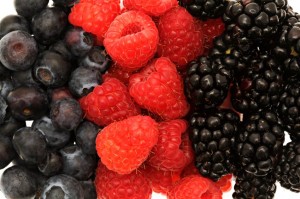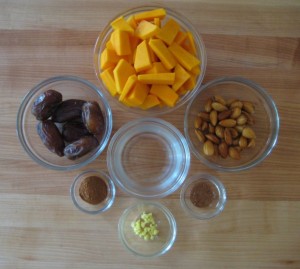 Ah, the holidays! Ever since I was a young girl I looked forward to the month of December for its festivities and time spent with family and friends. When I started on my raw food journey in 1990, I designed raw alternatives of my favorite holiday dishes and desserts to share with my loved ones. I included one of my recipes in an earlier blog post – butternut squash pudding, which has become a new holiday tradition in my family.
Ah, the holidays! Ever since I was a young girl I looked forward to the month of December for its festivities and time spent with family and friends. When I started on my raw food journey in 1990, I designed raw alternatives of my favorite holiday dishes and desserts to share with my loved ones. I included one of my recipes in an earlier blog post – butternut squash pudding, which has become a new holiday tradition in my family.
Spices that are often used in holiday recipes have been studied for their antioxidant content. The antioxidant activity of the compounds found in spices and foods has been measured using a system called ORAC, or oxygen radical absorbance capacity. An ORAC value of a food is a measurement of the ability of antioxidants in the food to neutralize free radicals in vitro (in a test tube or laboratory). The ORAC measurement has been questioned by members of the scientific community because it is measured in vitro and not in living organisms (in vivo). A free radical is a molecule with an unpaired electron that can cause damage to cells in our body.
Much is currently known about nutrition, and there is much that we have yet to learn. Our scientific, clinical, and experiential knowledge about nutrition is incomplete and will continue to increase as our inquiry in this area progresses. I personally would be interested to see the ORAC values of foods measured in humans and other living beings (in vivo). Hopefully this information will be available sometime in the future.
Here is a sampling of holiday spices and their respective ORAC values:
| Total ORAC value (µmol TE/100 g) | |
| Cinnamon, ground | 131,420 |
| Cloves, ground | 290,283 |
| Ginger, ground | 39,041 |
| Nutmeg, ground | 69,640 |
I was amazed to see the high ORAC value of these spices, especially when compared to popular high ORAC value foods, such as:
| Blackberries | 5,905 |
| Blueberries | 4,669 |
| Wild blueberries | 9,621 |
| Raspberries | 5,065 |

One might think, based on this information, that cinnamon, cloves, ginger, and nutmeg are superior sources of antioxidant activity to the fruits stated above. The spices are superior, PER 100 GRAMS. Please note that ORAC values for foods are reported per 100 grams.
But how much of each of these spices do we actually consume in a serving? Let’s do some simple calculations using ground cloves as an example. A typical 9” round pumpkin pie recipe calls for ¼ teaspoon of ground cloves. ¼ teaspoon of ground cloves weighs approximately 1 gram. The ORAC value for 100 grams of ground cloves is 290,283. If we divide this number by 100, we get a value of almost 2903 for 1 g of ground cloves in a whole pumpkin pie.
Now, there are generally 8 pieces in an average pumpkin pie. So, if we divide 2903 by 8 we get a value of about 363 for the 0.125 grams of ground cloves in one piece of pumpkin pie. Given that ORAC values are tested and reported per 100 grams of food, I cannot say that 363 is THE ORAC value for the 0.125 grams of ground cloves found in the piece of pie. I would need actual studies to confirm or deny this number, since other possible contributory factors must be taken into account. The bottom line here is that one needs to consider nutritional information, such as ORAC values, in the context of the amounts that one actually eats.
For comparison with another type of food, let’s consider the ORAC value and the amount of blackberries in one serving. The ORAC value for 100 g of blackberries is 5,905. One cup of blackberries weighs 144 g, so the ORAC value for 100 g of blackberries is very roughly equivalent to ⅔ of a cup, which could be considered a small serving of blackberries. Whenever I eat blackberries, I usually eat more than ⅔ cup, as do many raw food enthusiasts that I know.
Looking at the actual serving sizes of ground cloves and blackberries, one can strongly question the ORAC superiority of ground cloves to blackberries, or any of the other fruits shown in the table above. Of course, we would need more information on the antioxidant activity in the amount of cloves found in a piece of pumpkin pie to make a more definitive statement.
I would love to see researchers take into account such information when doing their studies, since this would make their information more meaningful and applicable to daily life. In the meantime, we must employ our skills of critical thinking when we hear such pieces of information out of context. Critical thinking is essential in many aspects of life, including the realm of nutrition information. We will address critical thinking in future blog posts.
For those of you interested in delving more deeply into this subject, here are some interesting points to note:
- The ORAC values reported are for dried and ground spices. I am curious to know if/how the ORAC value would differ in the fresh versions of these spices, especially ginger, since it is a naturally water-rich root.
- ORAC values are measured by weight, per 100 grams. I would like to see an ORAC value comparison per calorie, and as stated earlier, per serving size.
- If the food in question is part of a recipe or processed food, what other ingredients and/or processing methods can affect the ORAC value of that food?
For more information on the ORAC values of various foods, please visit: USDA nutrient database and USDA Database for the Oxygen Radical Absorbance Capacity (ORAC) of Selected Foods, Release 2 – May 2010
Best wishes for a happy and healthy new year!
One of the best ways to keep in touch with us is to join our email list. You’ll receive a free copy of Our Top 12 Strategies for Long Term Success on A Raw Plant-Based Diet eBook along with regular information about raw food and plant-based diets and periodic promotions for our classes, events, and other offerings!
Ultra simple raw food recipe for butternut squash pudding
‘Tis the season to be festive, so Rick and I thought we would share one of our favorite holiday recipes with you! We have always loved pumpkin pie, so this recipe is a raw, whole food sweetened version of the filling for the traditional favorite.

A very popular question that we are asked is “what type of sweetener do you use?” We very rarely use sweeteners in our recipes, but when we do use a sweetener, it is dates. There many possible alternative sweeteners which each may be more appropriate for specific recipes, but we prefer to use dates because they are a whole food and we enjoy the taste. We also consider simplicity and nutrient content when developing our recipes.

Here is the recipe, which makes 24 ounces or four 6-ounce servings:
- 2 Cups peeled fresh butternut squash
- 6 Medjool dates or ¾ cup of other type of dates
- ⅓ Cup soaked raw almonds (best if soaked for at least 8 hours prior to making recipe)
- ½ Cup good quality water (more may be necessary)
- 1 Tsp. ground cinnamon
- ½ Tsp. chopped fresh ginger
- ¼ Tsp. ground nutmeg
This recipe can also be used as filling for a raw pie, or one can substitute 2 cups of chopped pumpkin for the butternut squash if desired. Just remember to use pie pumpkin, which we have found to be more flavorful than the Jack-o-lantern type. 🙂

Here is how we prepare this recipe:
- Add ½ cup water to high powered blender, followed by spices and dates
- Blend until ingredients are reasonably homogenous
- Add ½ cup of butternut squash to mixture and blend, then add ½ cup of squash and blend, continue this process until all squash is blended with the mixture
- We often add some extra water during this process, if the mixture is too thick
- Add soaked almonds to the mixture and blend until mixture is completely smooth
- Pour into dessert glasses and sprinkle a pinch of ground cinnamon on top
- Chill and enjoy!
Have a Happy Thanks Living!
One of the best ways to keep in touch with us is to join our email list. You’ll receive a free copy of Our Top 12 Strategies for Long Term Success on A Raw Plant-Based Diet eBook along with regular information about raw food and plant-based diets and periodic promotions for our classes, events, and other offerings!
